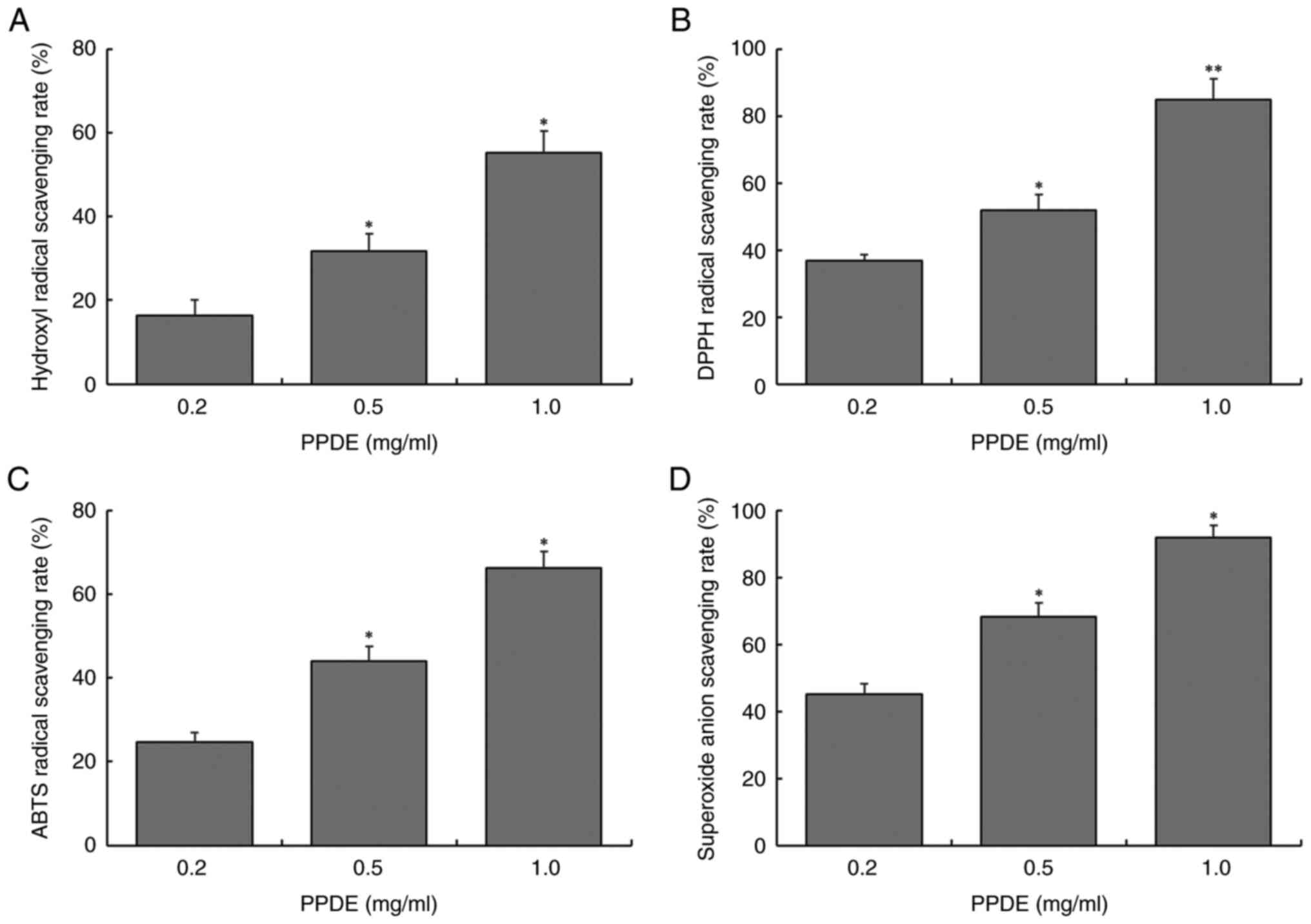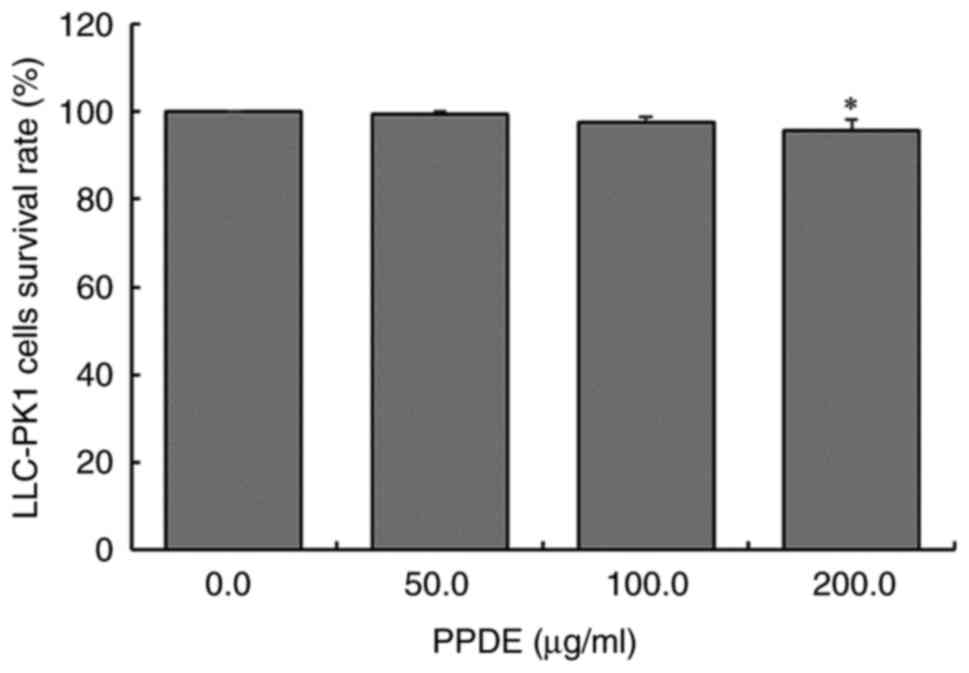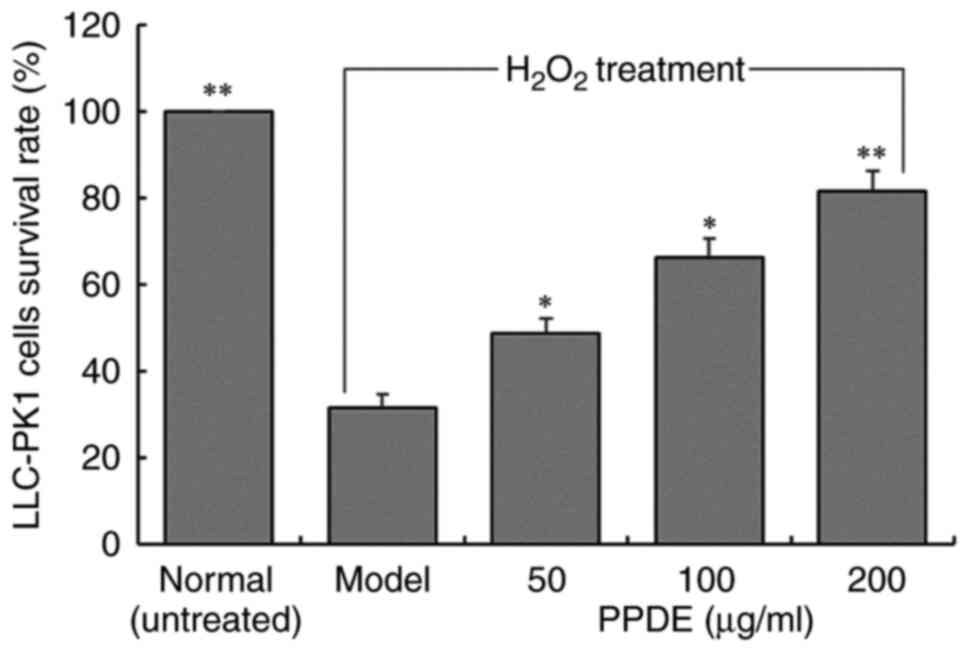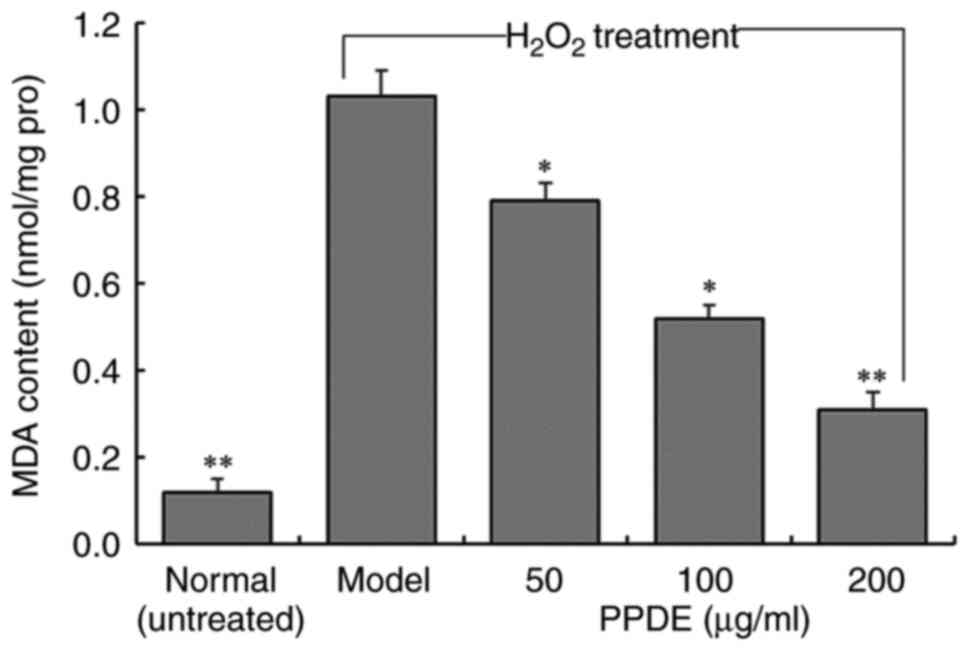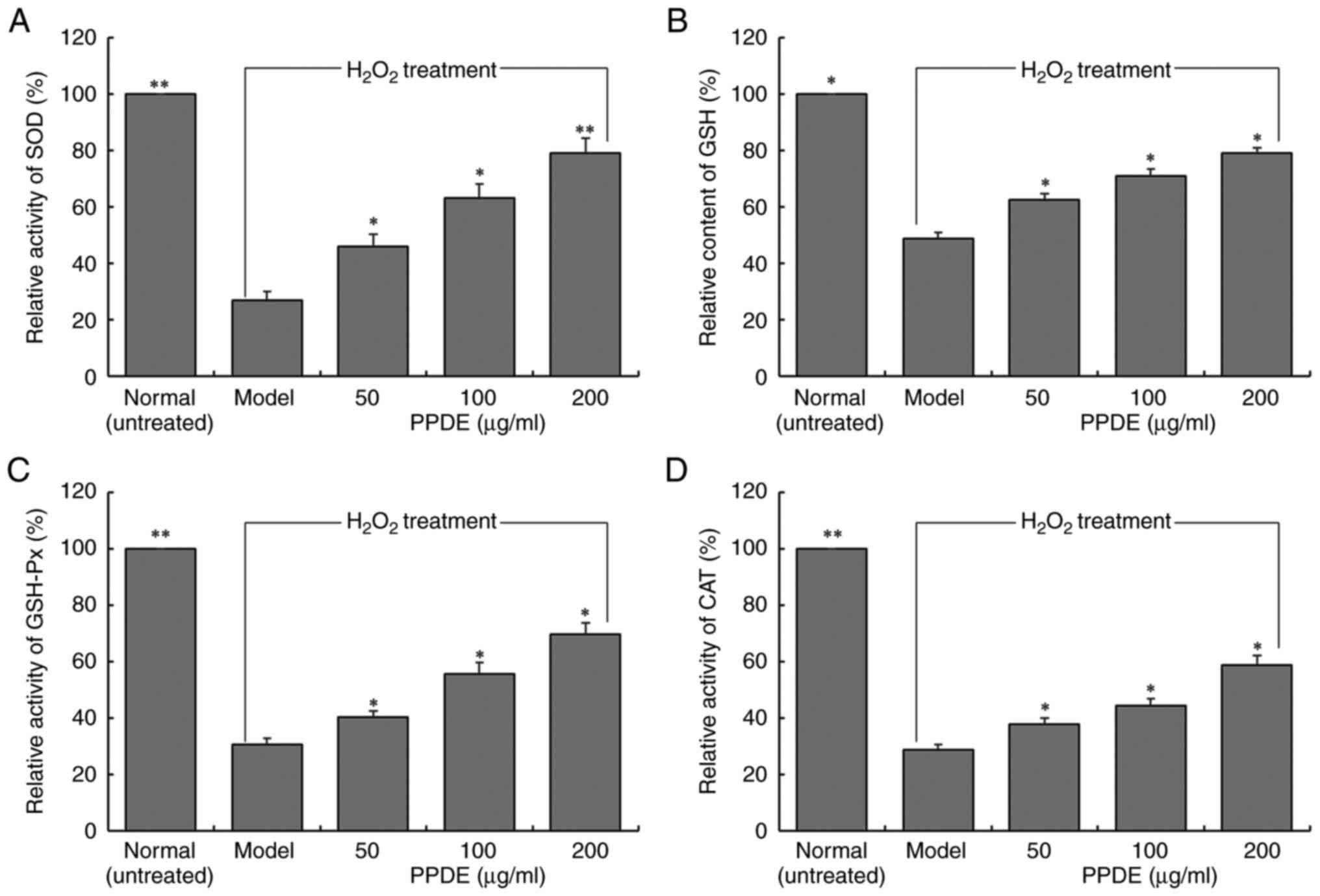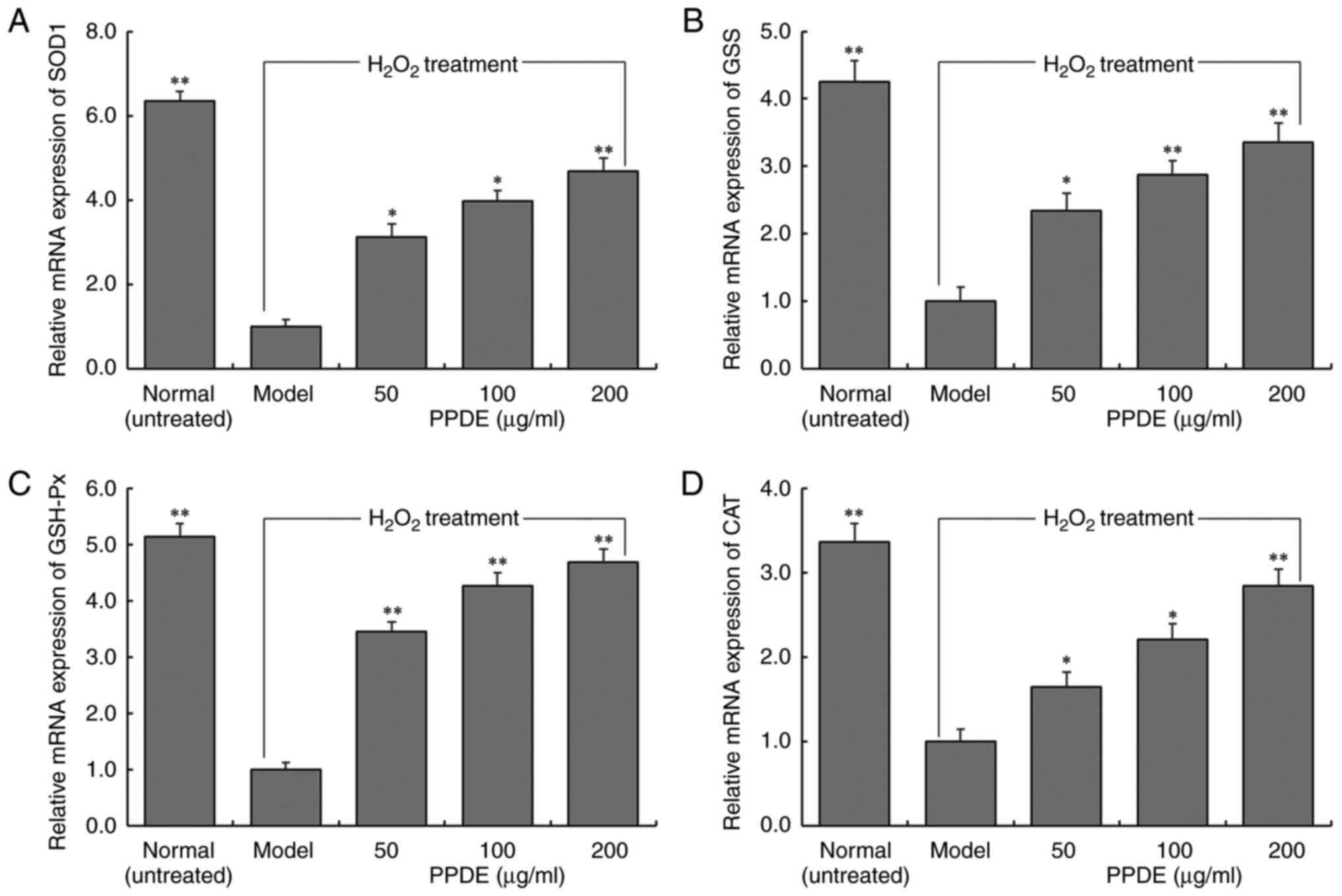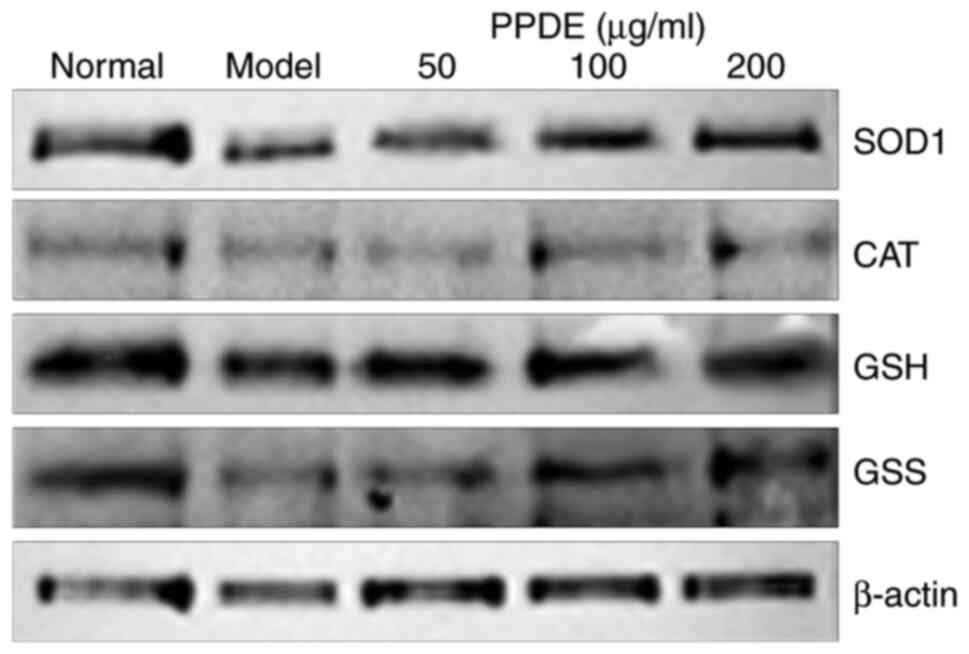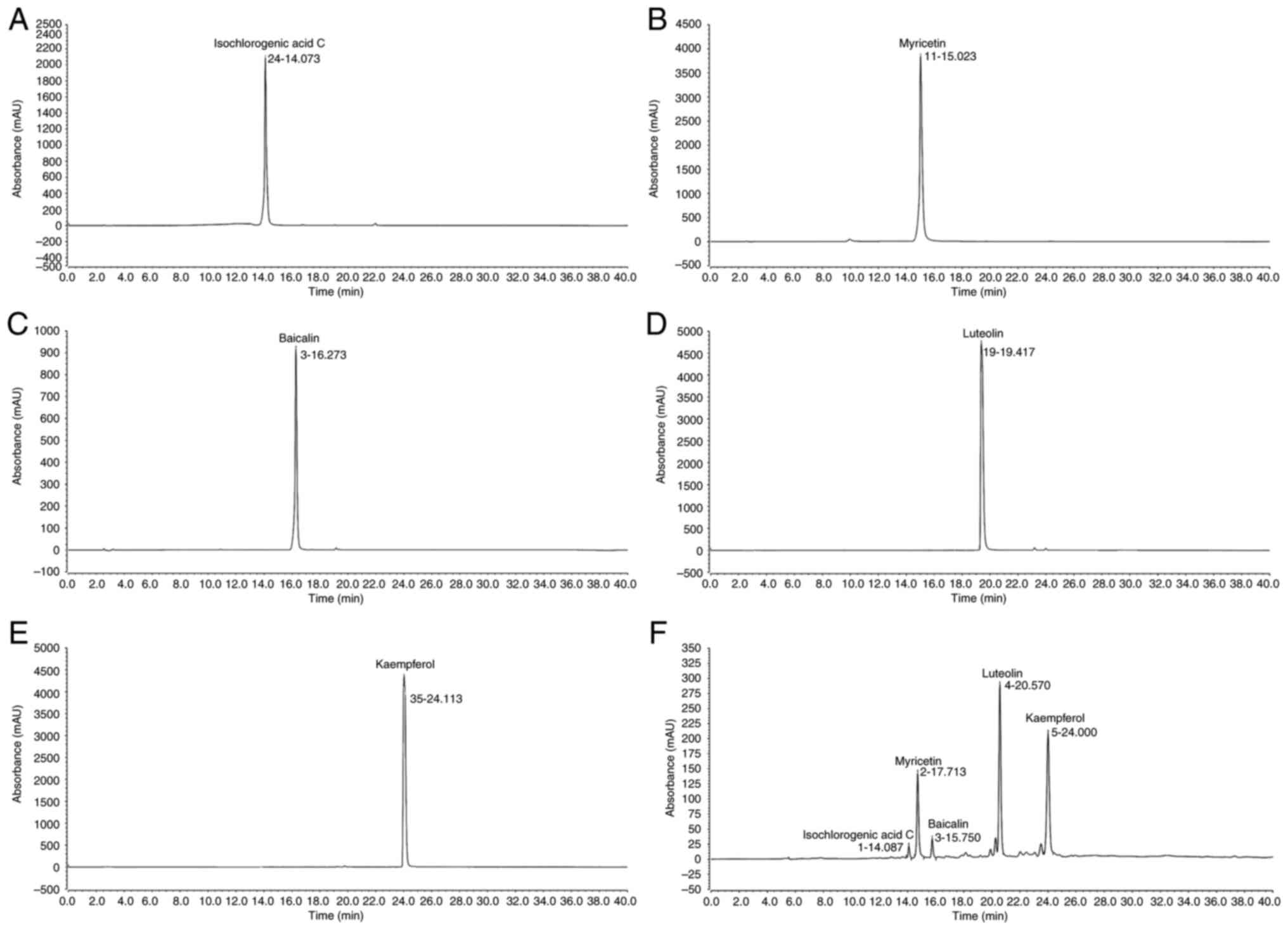Protective effect of Peucedanum praeruptorum Dunn extract on oxidative damage of LLC‑PK1 cells induced by H2O2
- Authors:
- Published online on: September 21, 2023 https://doi.org/10.3892/etm.2023.12216
- Article Number: 517
-
Copyright: © Hu et al. This is an open access article distributed under the terms of Creative Commons Attribution License.
Abstract
Introduction
Peucedanum praeruptorum Dunn is a perennial herb, which is primarily found distributed on hillside forest edges, the roadside, or semi-negative hillside grass at an altitude of 250-2,000 meters in China. The dry root donor-part of Peucedanum praeruptorum Dunn is currently used in traditional Chinese medicine, exerting an effect on exogenous wind-heat; lung heat and phlegm depression; cough, asthma, and phlegm; and tightness in the chest and diaphragm (1). The root of Peucedanum praeruptorum Dunn contains a variety of coumarin compounds and these active substances are also independently used in health products (2-5).
Free radicals and reactive oxygen species, such as the superoxide anion, peroxy ion, hydroxyl radical, hydrogen peroxide, and peroxynitrite, are metabolic byproducts produced by organisms during aerobic respiration. Excessive accumulation of ROS in the body can cause oxidative stress in cells and tissues, particularly within renal epithelial cells, and this is considered to be one of the major pathogenic factors leading to renal disease (6). It is important to highlight that among the various ROS, hydrogen peroxide (H2O2) can easily penetrate the cell membrane and enter the cytoplasm, leading to lipid peroxidation of cell membranes. This ultimately results in renal cell injury and subsequent necrosis of renal tissue (7). Under physiological conditions, the body possesses endogenous antioxidant systems, such as catalase (CAT), superoxide dismutase (SOD), glutathione peroxidase (GSH-Px), and non-enzymatic glutathione (GSH). These endogenous antioxidants play a crucial role in scavenging free radicals and ROS, thereby reducing oxidative stress-induced damage. Furthermore, consuming antioxidant-rich foods or supplements can enhance the body's intrinsic antioxidant capacity and mitigate the detrimental effects of oxidative stress on kidney function (8,9).
In the present study, pig renal epithelial LLC-PK1 cells were cultured in vitro to establish an oxidative damage model of epithelial cells induced by H2O2. The aim of this study was to investigate the in vitro free radical scavenging ability of PPDE and its protective mechanism against oxidative stress-induced injury in porcine renal epithelial cells stimulated with H2O2. These findings may serve as a theoretical foundation for exploring the potential health benefits and disease prevention properties of PPDE in oxidative stress-related renal diseases.
Materials and methods
PPDE extraction
Freshly collected Peucedanum praeruptorum Dunn (Hebei Anguo Ruiqi Traditional Chinese Medicine Co., Ltd, Anguo, Hebei, China) was freeze-dried and then milled into a fine powder. PPDE powder and an 80% ethanol solution were mixed in a ratio of 1:9 before being extracted at 50˚C for 1 h and then filtered. The filter residue was collected for another subsequent extraction. The two extracts were combined and evaporated by rotary evaporation to obtain PPDE.
DPPH radical scavenging
A volume of 0.5 ml PPDE with different concentrations (0-2.0 mg/ml) was added to 2 ml DPPH ethanol solution (0.33 mM), mixed, and allowed to stand in the dark at room temperature for 30 min. The absorbance of the tested solutions was determined at 517 nm with three in each group in parallel (10). The calculation formula of DPPH radical scavenging rate (%) was [1-(Ae-Af)/Ag] x100 where Ae is the OD value of the DPPH working solution + PPDE solution; Af is the blank correction, the OD value of PPDE solution + ethanol; and Ag is the blank control, the OD value of DPPH working solution + ethanol. Under a concentration range of 0-1.2 mg/ml, the DPPH free radical scavenging ability of PPDE showed a positive correlation with the concentration. However, no significant difference in effect was observed beyond a concentration of 1.2 mg/ml (Fig. S1). Therefore, for the purpose of conducting the free radical scavenging experiments, experimental concentrations of 0.2, 0.5, and 1.0 mg/ml were selected.
Hydroxyl radical scavenging
Salicylic acid colorimetry was used (11). First, a 10-ml test tube with a stopper was used to collect the following experimental solution. First, 2 ml 0.2, 0.5, or 1.0 mg/ml PPDE solution was added. Next, 2 ml 9 mmol/l ethanol salicylic acid solution and 1 ml 9 mmol/l ferrous sulfate solution (prepared by ferrous sulfate heptahydrate) were added, and finally, 2 ml 8.8 mmol/l H2O2 was added to initiate the reaction. Mixtures were incubated in a 37˚C water bath for 30 min, and OD values were measured at 510 nm, with three in each group in parallel. The calculation formula of the hydroxyl radical scavenging rate (%) was [1-(Ab-Ac)/Ad] x100 where Ab is the OD value of the working solution after the addition of PPDE; Ac is the double-distilled water instead of H2O2 as the background colorimetric OD value; and Ad is the OD value of the blank control solution.
ABTS radical scavenging
A volume of 5 ml was taken out from the plugged test tube, 1 ml ABTS free radical working solution was added, followed by 0.4 ml 0.2, 0.5, or 1.0 mg/ml PPDE solution. The solvent was placed in the dark for 30 min and then the OD value was determined at 734 nm with three in each group in parallel. The ABTS free radical working solutions were prepared as follows: Solution A, 3 mg ABTS was added to 0.8 ml double distilled water, mixed and dissolved; and solution B, 1 mg potassium persulfate was added to 1.5 ml double distilled water, mixed and dissolved (12). The calculation formula of ABTS radical scavenging rate (%) was [1-(Ai-Aj)/Ao] x100 where Ai is the OD value of ABTS working fluid + PPDE fluid; Aj is the blank correction, the OD value of PPDE solution + absolute ethanol; and Ao is the blank control, ABTS working solution + absolute ethanol OD value.
Superoxide anion scavenging
For the superoxide anion scavenging experiment, the pyrogallol autoxidation method was adopted (13). The SOD activity of samples was detected using a kit (cat. no. A001-3-2; Nanjing Jiancheng Bioengineering Institute), and the absorbance value was tested at 320 nm with three in each group in parallel. The calculation formula used for the superoxide anion radical scavenging rate (%) was [1-(Am-An)/Ap] x100 where Am is the OD value of the superoxide anion working solution + PPDE solution; An is the pyrogallol replaced with deionized water as the background OD value of PPDE; and Ap is the OD value of deionized water instead of PPDE.
LLC-PK1 cell culture
Pig renal epithelial LLC-PK1 cells were removed from the cryopreservation tubes from the liquid nitrogen and transferred to a 37˚C water bath for 15 min to facilitate cell recovery. Subsequently, the cells were placed in a demethylated medium (Beijing Solarbio Science & Technology Co., Ltd.), which is a high-sugar solution supplemented with 10% FBS and 1% penicillin-streptomycin double antibiotic solution. Cells were maintained in a humidified incubator at 37˚C supplied with 5% CO2 air. The medium was changed 2-3 times per week. When the confluency reached 90%, trypsin (0.25%) was used to digest cells and subculture. Cells in the logarithmic growth phase cells were used in all experiments.
MTT assay
The cytotoxicity of the PPDE solution was assessed. LLC-PK1 cell suspensions (1x104 cells/ml) were plated into 96 well cell culture plates (60 µl cell + 100 µl medium) cultured at 37˚C for 24 h before 20 µl of the different concentrations of PPDE solutions were added (0, 50, 100, or 200 µg/ml) for 24 h. Then, 20 µl MTT (5 mg/ml) was added, mixed, and cultured for a further 4 h. Subsequently, the media was removed, and 150 µl DMSO was added and incubated at 37˚C on a shaker for 30 min in the dark. The OD value was measured at 490 nm (14).
The protective effect of PPDE on oxidative damage of LLC-PK1 cells induced by H2O2 was assessed. The LLC-PK1 cell suspensions (1x104 cells/ml) were plated in 96 well cell culture plates (60 µl cell + 100 µl medium), cultured at 37˚C for 24 h, and then 20 µl H2O2 (0.3 mmol/l) was added. Cells were cultured for 4 h to allow for the establishment of the oxidative damage model. A total of 20 µl of the PPDE solutions was added (final concentration, 0-300 µg/ml) was added to cells and cultured for 24 h. Next, 20 µl MTT solution was added, and cells were incubated for a further 4 h. The media was removed and 150 µl DMSO was added before incubation at 37˚C in the dark on a shaker for 30 min. The OD value was measured at 490 nm (15). At concentrations ranging from 0-250 µg/ml, the cellular antioxidant capacity of PPDE exhibited a positive correlation with the concentration used. However, no significant difference in effect was observed when the concentration exceeded 250 µg/ml (Fig. S2). Therefore, for subsequent experiments, the experimental concentrations of PPDE used were 50, 100, and 200 µg/ml.
Determination of intracellular contents of MDA, SOD, GSH, GSH-Px, and CAT
LC-PK1 cells in the logarithmic growth stage were digested using 0.25% trypsin and plated into 6-well cell culture plates (1x105 cells/ml). A total of 2 ml DMEM (Beijing Solarbio Science & Technology Co., Ltd) was added to cells and cultured for 24 h. Next, 200 µl H2O2 (0.3 mmol/l) was added. After cells had adhered, cells were treated with H2O2 and cultured for 4 h to establish the oxidative damage model. Next, 200 µl of different concentrations of PPDE solution (0, 50, 100, or 200 µg/ml) per well and PBS buffer (0.1 M) were added to cells, and incubated for 24 h.
LLC-PK1 cells treated with PPDE were washed with precooled PBS and had 200 µl trypsin added. Detached cells were collected, transferred to a 1.5 ml centrifuge tube, and centrifuged (1,006 x g, 4˚C, 5 min) to remove the supernatant. Precooled PBS was used to wash the cells again, and centrifuged again at 1,006 x g for 15 min at 4˚C, and the supernatant was removed. A total of 800 µl normal saline was added and the levels of MDA (cat. no. A003-1-2), SOD (cat. no. A001-3-2), GSH (cat. no. A006-1-1), GSH-Px (cat. no. A005-1-2), and CAT (cat. no. A007-1-1) in cell homogenates were measured using the specific kits (Nanjing Jiancheng Bioengineering Institute).
Reverse transcription-quantitative (RT-q)PCR
LC-PK1 cells were plated in a 10 cm cell culture dish. After treatment as described above, TRIzol® reagent was used to extract total RNA. After purity detection using the UV method (measurement of absorbance at 260 and 280 nm, and calculating the absorbance ratio of OD260/OD280), the concentration of total RNA in all sample groups was adjusted to 1 µg/µl. An equal amount of RNA (2 µg) was added to each group with oligodT18, RNase, dNTP, and 1 µl MLV enzyme, and 10 µl 5x Buffer. The cDNA was synthesized in a total volume of 20 µl at 37˚C for 120 min, 99˚C for 4 min, and 4˚C for 3 min. After reverse transcription, qPCR was performed. The thermocycling conditions were: Pre-denaturation at 95˚C for 5 min; followed by 35 cycles of annealing at 58˚C for 50 sec and extension at 72˚C for 90 sec; and a final extension at 72˚C for 10 min. GAPDH was used as an internal reference, and the expression was calculated using the 2-∆∆Cq method (16,17). The sequences of the primers used for qPCR are listed in Table I.
Western blotting
The cells were washed three times with pre-cooled PBS before being homogenized with protein lysate and centrifuged at 11,180 x g for 15 min at 4˚C. Protein concentration was determined using a BCA protein assay. Next, sample buffer was added to the protein samples and heated at 100˚C for 10 min. On a PAGE Bis-Tris pre-gel, the pre-mixed samples and protein ladder were loaded (1 µg). Following SDS-PAGE, proteins were transferred to PVDF membranes, which were blocked for 1 h with 5% skimmed milk in TBST. The PVDF membranes were then incubated with primary antibodies against SOD1 (cat. no. MA1-105; monoclonal antibody; 1:100 dilution), CAT (cat. no. MA5-37595; monoclonal antibody; 1:1,600 dilution) or β-actin (cat. no. MA1-140; monoclonal antibody; 1:5,000 dilution) (all Thermo Fisher Scientific, Inc.) at 25˚C for 2 h. The PVDF membranes were then washed five times with TBST for 5 min each, followed by a 1-h incubation with the secondary antibody (cat. no. A-11001; goat anti-mouse IgG; 1:1,000 dilution; Thermo Fisher Scientific, Inc.) at 25˚C. Finally, to visualize signals, an enhanced chemiluminescence analysis kit (GE Healthcare) on a LAS3000 luminescent image analyzer (Fujifilm Corporation).
HPLC
The test solution was established by dissolving standards and sample extracts in methanol. The chemical composition of the PPDE was then determined using the following chromatographic apparatus: AcclaimTM120 C18 column, 4.6x150 mm, 5 µm in length; mobile phase, methanol-0.5% glacial acetic acid; detection wavelength, 359 nm; column temperature, 35˚C; flow rate, 0.6 ml/min; PPDE intake, 20 µl (UltiMate 3000, Thermo Fisher Scientific, Inc.).
Statistical analysis
Data are presented as the mean ± SD and were analyzed using SAS 9.2 (SAS Institute, Inc.). Differences were compared using a one-way ANOVA followed by a Duncan's post-hoc test. P<0.05 was considered to indicate a statistically significant difference.
Results
Free radical scavenging ability of PPDE in vitro
As shown in Fig. 1, at concentrations of 0.2, 0.5, or 1.0 mg/ml, the scavenging rates of PPDE on hydroxyl radicals (16.3, 31.8, and 55.2%, respectively), DPPH radicals (36.8, 51.9, and 84.9%, respectively), ABTS radicals (24.7, 43.9, and 66.3%, respectively), and superoxide anion radicals (45.0, 68.3, and 91.8%, respectively) were significantly enhanced, indicating that the scavenging capacity of PPDE on four free radicals was dose-dependent and there were significant differences between different concentrations (P<0.05).
LLC-PK1 cell survival rate
As shown in Fig. 2, after 0, 50, 100, or 200 µg/ml PPDE treatment, the survival rate of LLC-PK1 cells was almost 96%. This suggested that PPDE had no notable toxic effects on normal cells at concentrations at or below 200 µg/ml. Therefore, 50, 100, and 200 µg/ml PPDE were used for all subsequent experiments.
The survival rates of LLC-PK1 cells with H2O2-induced oxidative damage were decreased compared with those of untreated normal cells (Fig. 3). Compared with the injured cells, after 50, 100, or 200 µg/ml PPDE treatments, the cell survival rates were significantly improved, and a concentration of 200 µg/ml exhibited a more significant protective effect (P<0.05).
MDA content in oxidation-damaged LLC-PK1 cells following PPDE treatment
The MDA content of H2O2-treated LLC-PK1 cells was significantly higher than untreated normal cells (Fig. 4, P<0.05). At different concentrations of PPDE, the MDA content of the cells was reduced in a dose-dependent manner, and the effect of 200 µg/ml PPDE had the most notable effect on MDA content.
Changes in SOD, GSH, GSH-Px, and CAT levels in oxidation-damaged LLC-PK1 cells treated with PPDE
The enzymatic activities of SOD, GSH-Px, and CAT and the content of GSH in LLC-PK1 cells in the normal group were significantly higher than those in the model group (Fig. 5, P<0.05). Treatment with PPDE significantly increased the SOD, GSH-Px, and CAT enzyme activities and the GSH content of cells (P<0.05), and it was positively correlated with the dose.
Effect of PPDE on mRNA expression in damaged LLC-PK1 cells
The mRNA expression levels of SOD1, GSS, GSH-Px, and CAT in normal cells decreased significantly following induced oxidation (Fig. 6, P<0.05). The effect of PPDE was found to significantly upregulate the expression of SOD1, GSH, GSH-Px, and CAT in oxidation-damaged cells (P<0.05). These results were consistent with the results of the changes in the enzymatic activities of these enzymes determined above.
Effect of PPDE on protein expression in damaged LLC-PK1 cells
Western blotting showed that the normal group had higher protein expression levels of CAT, SOD1, GSH, and GSS compared with the model group. Compared to the model group, PPDE notably upregulated the protein expression levels of CAT, SOD1, GSH, and GSS, and it was positively correlated with concentration (Fig. 7).
Composition of PPDE
Component analysis revealed that the primary PPDE constituents were: Isochlorogenic acid, myricetin, baicalin, luteolin, and kaempferol (Fig. 8).
Discussion
In the preliminary experiments, the toxicity of PPDE on LLC-PK1 cells, human umbilical vein endothelial cells (HUVECs) and melan-a mouse melanocytes was examined (data not shown). The results demonstrated that PPDE did not exhibit any significant toxic effects on these three types of cells. Although further investigation is necessary to determine the underlying mechanism. Similar to a previous study, LLC-PK1 cells have been shown to be responsive to antioxidant treatments and are considered to be a well-established cell line for assessing antioxidant effects (18). In the present study, the effect of PPDE on LLC-PK1 cells was primarily investigated, and our future studies will focus on validating these findings and elucidating the underlying mechanisms in other cell lines.
Oxygen free radicals have the potential to attack polyunsaturated fatty acids present in biofilms, leading to lipid peroxidation and subsequent oxidative damage to cells (19). To counteract this oxidative stress, the body possesses intrinsic antioxidant systems. There are two primary defense mechanisms against oxidative stress in humans. The first is the enzymatic antioxidant system, consisting of vital enzymes such as SOD, GSH-Px, and CAT. The second line of defense is the non-enzymatic antioxidant system, primarily relying on dietary antioxidants such as vitamins C and E, glutathione, carotenoids, copper, selenium, and zinc, amongst others. Antioxidant compounds in food, such as proanthocyanidins found in blueberries and citrus fruits, in addition to dietary nutritional supplements, which are often derived from active components of foods or plants, play a significant role in enhancing the antioxidant activity and scavenging of free radicals (20). The rapid in vitro antioxidant evaluation method used in the present study can be employed to initially assess the antioxidant effect of natural products. Exogenous antioxidants found in foodstuffs are the most reliable method to improve the antioxidant capacity of cells (21). In vitro antioxidant activity is measured in a laboratory setting outside of living organisms, using direct reactions with free radical reagents. One of the most commonly used in vitro antioxidant experiments is the DPPH method (10,22,23). DPPH is a stable free radical compound that is soluble in ethanol and has a dark purple color. Ultraviolet detection is used to assess the antioxidant potential of substances added to a reaction; if the color of the solution becomes lighter, it indicates the presence of in vitro antioxidant capacity. If in vitro antioxidant capacity is observed, further in vivo experiments are warranted (22). Hydroxyl radicals can cause oxidative damage to DNA, proteins, and lipids. The effects of antioxidants on oxidative damage can be detected by capturing ·OH in a Fenton reaction system using salicylic acid (23). The chemical ABTS can be oxidized into blue-green ABTS·+ by oxidants, and its color can become faded under the action of antioxidants. Under alkaline conditions, pyrogallol can rapidly self-oxidize, release O2-, and generate colored intermediates. After the reaction is initiated, the reaction liquid first turns yellow and brown, then turns green after a few minutes, and ultimately turning yellow again after a few hours, which is due to the continuous oxidation of the intermediates generated (24). Evaluation of the scavenging ability of a single free radical cannot comprehensively evaluate the antioxidant activity of any given antioxidant, and hence the scavenging ability of various free radicals should be comprehensively evaluated in such studies. In the present study, PPDE had a scavenging effect on DPPH, ·OH, O2- and ABTS free radicals, and the effect was notable.
MDA is one of the final products of membrane lipid peroxidation. Its concentration can serve as an indicator to assess the severity of cellular stress. The content of MDA is an important parameter that reflects the potential antioxidant capacity of the body, indicating the rate and intensity of lipid peroxidation and the extent of peroxidation damage (25). Due to its possession of a single electron, MDA can react with various cellular components, including normal cells, proteins, and lipids, resulting in changes in their structure and characteristics. For instance, lipids can be oxidized by free radicals to produce MDA, which is considered a highly destructive substance. The presence of MDA can lead to the polymerization of nucleic acids, proteins, and other polymers, resulting in the formation of insoluble lipofuscin. This series of oxidative events accelerates the aging process in the body (26). In the present study, the MDA levels in LLC-PK1 cells increased after H2O2-treated injury and decreased after PPDE treatment. The antioxidant enzymes or non-enzyme antioxidant substances CAT, SOD, GSH-Px, and GSH can play either their respective roles or play a combined role in inhibiting oxidative damage in the body. As different metal ions bind with the auxiliary groups of SOD, SOD is present in three forms: Mn-SOD, Cu/Zn-SOD, and Fe-SOD. Research has shown that SOD can convert excess O2- into H2O2 and then be converted into H2O by either CAT or GSH-Px (27). The antioxidant CAT has a specific affinity for H2O2 and can react with H2O2 to generate H2O, which is then transformed into a non-toxic substance (28). GSH-Px is an important peroxidase decomposition enzyme ubiquitously present throughout the body. The active center of GSH-Px is selenocysteine, and its activity can reflect the selenium (Se) levels of the body. Se is a component of the GSH-Px enzyme system, and it can catalyze GSH into GSSG, reduce toxic peroxide into non-toxic hydroxyl compounds, and promote the decomposition of H2O2, ultimately protecting the structure and function of cell membranes from oxide interference and damage. Glutathione reductase can catalyze GSSG to produce GSH using NADPH (29). In addition, PPDE can also help to enhance its antioxidant activity and alleviate cell injury by upregulating the transcription of CAT, SOD, and GSH-Px antioxidant enzymes, as well as the non-enzymatic antioxidant GSH in mRNA in cells damaged by oxidative stress. The present study found that after treatment with different concentrations of PPDE, the contents of the antioxidant enzymes CAT, SOD, and GSH-Px and the non-enzymatic antioxidant GSH in damaged cells increased significantly. The increase in the content of these important antioxidant enzymes contributed to the inhibition to inhibition of lipid peroxidation and alleviated further cell damage.
Isochlorogenic acid C, myricetin, baicalin, luteolin, and kaempferol are all active substances with antioxidant effects. They also showed bioactive effects on cells (30-34). In the present study, PPDE also exerted a potent protective effect on normal cells from oxidative stress damage. However, PPDE is a complex mixture, and the present study was not able to ascertain whether its effects were due to a combination of multiple compounds or a significant impact of a single component. Based on the results of the present study, it was hypothesized that the substantial presence of luteolin and kaempferol may be the primary contributing factors to its effects.
In conclusion, the antioxidant activity of PPDE was evaluated using in vitro experiments, and its beneficial effects and potential active components involved in reducing oxidative stress were preliminarily analyzed. The results showed that PPDE had significant effects on DPPH, ·OH, and O2- levels and that ABTS showed these radicals to have been subjected to significant scavenging activities by PPDE administration. Additionally, PPDE also increased the contents of the major antioxidant enzymes CAT, SOD, and GSH-Px as well as the non-enzymatic antioxidant GSH. qPCR showed that PPDE could also upregulate the mRNA levels of antioxidant enzymes, and this may underlie its ability to alleviate oxidative stress. Peucedanum praeruptorum may protect the kidney and inhibit nephropathy by reducing the levels of oxidative stress in renal cells, which is conducive to the development of novel antioxidant substances and renal-protective functional foodstuffs. In future research, other detection methods, including flow cytometry, and more in-depth animal experiments need to be further used to evaluate the efficacy of PPDE.
Supplementary Material
DPPH scavenging effect of 0-2 μg/ml PPDE. PPDE< Peucedanum praeruptorum Dunn extract.
Effect of 0-300 μg/ml PPDE treatment on the survival of oxidatively damaged LLC-PK1 renal tubular epithelial cells. PPDE, Peucedanum praeruptorum Dunn extract.
Acknowledgements
Not applicable.
Funding
Funding: This research was funded by the Science and Technology Project of Chongqing Education Commission (grant no. KJZD-M201901601) and Chongqing University Innovation Research Group Project (grant no. CXQTP20033).
Availability of data and materials
The datasets used and/or analyzed during the current study are available from the corresponding author on reasonable request.
Authors' contributions
SH and PW performed the majority of the experiments and wrote the manuscript. JK, JH, CW and JL contributed to the data analysis. SC designed the study. All authors have read and approved the final manuscript. SH and SC confirm the authenticity of all the raw data.
Ethics approval and consent to participate
Not applicable.
Patient consent for publication
Not applicable.
Competing interests
The authors declare that they have no competing interests.
References
|
Yu PJ, Jin H, Zhang JY, Wang GF, Li JR, Zhu ZG, Tian YX, Wu SY, Xu W, Zhang JJ and Wu SG: Pyranocoumarins isolated from Peucedanum praeruptorum Dunn suppress lipopolysaccharide-induced inflammatory response in murine macrophages through inhibition of NF-κB and STAT3 activation. Inflammation. 35:967–977. 2012.PubMed/NCBI View Article : Google Scholar | |
|
Gao M, Bian C, Zhou W, Liu L, Li B and Tang L: Dissipation of tiafenacil in five types of citrus orchard soils using the HPLC-MS coupled with the quick, easy, cheap, effective, rugged, and safe method. J Separat Sci. 44:1950–1960. 2021.PubMed/NCBI View Article : Google Scholar | |
|
Xiong YY, Wu FH, Wang JS, Li J and Kong LY: Attenuation of airway hyperreactivity and T helper cell type 2 responses by coumarins from Peucedanum praeruptorum Dunn in a murine model of allergic airway inflammation. J Ethnopharmacol. 141:314–321. 2012.PubMed/NCBI View Article : Google Scholar | |
|
Lee J, Lee YJ, Kim JH and Bang OS: Pyranocoumarins from root extracts of Peucedanum praeruptorum Dunn with multidrug resistance reversal and anti-inflammatory activities. Molecules. 20:20967–20978. 2015.PubMed/NCBI View Article : Google Scholar | |
|
Bi J, Gao Z, Zhang G and Chen Y: Research progress on anticancer effects and molecular mechanisms of osthole. Asian J Tradit Med. 16:53–62. 2021. | |
|
Liu J, Jia H, Zhu K, Zhao S and Lichtfouse E: Formation of environmentally persistent free radicals and reactive oxygen species during the thermal treatment of soils contaminated by polycyclic aromatic hydrocarbons. Environ Chem Lett. 18:1329–1336. 2020. | |
|
Bauer G: Inhibition of membrane-associated catalase, extracellular ROS/RNS signaling and aquaporin/H2O2-mediated intracellular glutathione depletion cooperate during apoptosis induction in the human gastric carcinoma cell line MKN-45. Antioxidants. 10(1585)2021.PubMed/NCBI View Article : Google Scholar | |
|
Ibrahim M, Ismail A, Al-Sheraji SH, Azlan A and Hamid AA: Effects of Mangifera pajang Kostermans juice on plasma antioxidant status and liver and kidney function in normocholesterolemic subjects. J Funct Foods. 5:1900–1908. 2013. | |
|
de Haan A, Eijgelsheim M, Vogt L, van der Zwaag B, van Eerde AM, Knoers NVAM and de Borst MH: Diagnostic yield of massively parallel sequencing in patients with chronic kidney disease of unknown etiology: Rationale and design of a national prospective cohort study. BMJ Open. 12(e057829)2022.PubMed/NCBI View Article : Google Scholar | |
|
Zhao X, Wang Q, Li G, Chen F, Qian Y and Wang R: In vitro antioxidant, anti-mutagenic, anti-cancer and anti-angiogenic effects of Chinese Bowl tea. J Funct Foods. 7:590–598. 2014. | |
|
Wang LX, Li CY, Hu C, Gong PS and Zhao SH: Purification and structural characterization of Dendrobium officinale polysaccharides and its activities. Chem Biodivers. 18(e2001023)2021.PubMed/NCBI View Article : Google Scholar | |
|
Takatsuka M, Goto S, Kobayashi K, Otsuka Y and Shimada Y: Evaluation of pure antioxidative capacity of antioxidants: ESR spectroscopy of stable radicals by DPPH and ABTS assays with singular value decomposition. Food Biosci. 48(101714)2022. | |
|
Xu SJ, Zhu Q, Wang ZH, Xu Y and Zou SJ: Scavenging activity of superoxide free radical of hesperidin and hesperetin. Acta Chinese Med Pharmacol. 2015:56–58. 2015. | |
|
Zhao X, Kim SY and Park KY: Bamboo salt has in vitro anticancer activity in HCT-116 cells and exerts anti-metastatic effects in vivo. J Med Food. 16:9–19. 2013.PubMed/NCBI View Article : Google Scholar | |
|
Zhao X, Yi RK, Feng X and Song JL: Protective effect of Korean sesame sauce on AAPH-induced oxidative stress in LLC-PK1 cells. Food Sci. 38:213–218. 2017. | |
|
Long X, Wu H, Zhou Y, Wan Y, Kan X, Gong J and Zhao X: Preventive effect of Limosilactobacillus fermentum SCHY34 on lead acetate-induced neurological damage in SD rats. Front Nutr. 9(852012)2022.PubMed/NCBI View Article : Google Scholar | |
|
Hu TT, Chen R, Qian Y, Ye K, Long XY, Park KY and Zhao X: Antioxidant effect of Lactobacillus fermentum HFY02-fermented soy milk on D-galactose-induced aging mouse model. Food Sci Human Wellness. 11:1362–1372. 2022. | |
|
Pine MD, Greer K and Busbee D: Comparison of reactive oxygen scavenging systems between a cetacean (DKN1) and a porcine renal epithelial cell line (LLC-PK1). Comp Biochem Physiol A Mol Integr Physiol. 147:550–555. 2007.PubMed/NCBI View Article : Google Scholar | |
|
Xu Y, Liu K, Jin R, Jiang D and Fang D: Dynamic visualization of free radicals at single oxygen bubbles using chemiluminescence. Chem Asian J. 16:4049–4052. 2021.PubMed/NCBI View Article : Google Scholar | |
|
Wang F, Yang Q, Zhao Q and Li X: Cold shock treatment with oxalic acid could alleviate chilling injury in green bell pepper by enhancing antioxidant enzyme activity and regulating proline metabolism. Sci Horticult. 295(110783)2022. | |
|
Zhang H, Zong R, He H and Huang T: Effects of hydrogen peroxide on Scenedesmus obliquus: Cell growth, antioxidant enzyme activity and intracellular protein fingerprinting. Chemosphere. 287(132185)2022.PubMed/NCBI View Article : Google Scholar | |
|
Huong DQ, Bay MV and Nam PC: Antioxidant activity of thiourea derivatives: An experimental and theoretical study. J Mol Liquids. 340(117149)2021. | |
|
Liao CY, Yang SF, Wu TJ, Chang H, Huang CYF, Liu YF, Wang CH, Liou JC, Hsu SL, Lee H, et al: Novel function of PERP-428 variants impacts lung cancer risk through the differential regulation of PTEN/MDM2/p53-mediated antioxidant activity. Free Radic Biol Med. 167:307–320. 2021.PubMed/NCBI View Article : Google Scholar | |
|
Li C, Chen S, Sha J, Cui J, He J, Fu J and Shen Y: Extraction and purification of total flavonoids from Eupatorium lindleyanum DC and evaluation of their antioxidant and enzyme inhibitory activities. Food Sci Nutr. 9:2349–2363. 2021.PubMed/NCBI View Article : Google Scholar | |
|
Le G, Yang L, Du H, Hou L, Ge L, Sylia A, Muhmood A, Chen X, Han B and Huang K: Combination of zinc and selenium alleviates ochratoxin A-induced fibrosis via blocking ROS-dependent autophagy in HK-2 cells. J Trace Elem Med Biol. 69(126881)2022.PubMed/NCBI View Article : Google Scholar | |
|
Ni CX, Gong H, Liu Y, Qi Y, Jiang CL and Zhang JP: Green tea consumption and the risk of liver cancer: A meta-analysis. Nutr Cancer. 69:211–220. 2017.PubMed/NCBI View Article : Google Scholar | |
|
Du W, Zhai P, Liu S, Zhang Y and Lu L: The copper chaperone CcsA, coupled with superoxide dismutase SodA, mediates the oxidative stress response in Aspergillus fumigatus. Appl Environ Microbiol. 87(e0101321)2021.PubMed/NCBI View Article : Google Scholar | |
|
Ren H, Li J, Liu P, Ren X, Song T, Gao G, Li D and Liu S: Cloning of catalase gene and antioxidant genes in Scophthalmus maximus response to metalloprotease of Vibrio anguillarum stress. J Oceanol Limnol. 40:322–335. 2022. | |
|
Gao Z, Gao X, Fan W, Liu S, Li M, Miao Y, Ding C, Tang Z, Yan L, Liu G, et al: Bisphenol A and genistein have opposite effects on adult chicken ovary by acting on ERα/Nrf2-Keap1-signaling pathway. Chem-Biol Interact. 347(109616)2021.PubMed/NCBI View Article : Google Scholar | |
|
Wang HN, Shen Z, Liu Q, Hou XY, Cao Y, Liu DH, Jiang HJ and Du HZ: Isochlorogenic acid (ICGA): Natural medicine with potentials in pharmaceutical developments. Chinese J Nat Med. 18:860–871. 2020.PubMed/NCBI View Article : Google Scholar | |
|
Phillips PA, Sangwan V, Borja-Cacho D, Dudeja V, Vickers SM and Saluja AK: Myricetin induces pancreatic cancer cell death via the induction of apoptosis and inhibition of the phosphatidylinositol 3-kinase (PI3K) signaling pathway. Cancer Lett. 308:181–188. 2011.PubMed/NCBI View Article : Google Scholar | |
|
Gao C, Zhou Y, Li H, Cong X, Jiang Z, Wang X, Cao R and Tian W: Antitumor effects of baicalin on ovarian cancer cells through induction of cell apoptosis and inhibition of cell migration in vitro. Mol Med Rep. 16:8729–8734. 2017.PubMed/NCBI View Article : Google Scholar | |
|
Wu B, Zhang Q, Shen W and Zhu J: Anti-proliferative and chemosensitizing effects of luteolin on human gastric cancer AGS cell line. Mol Cell Biochem. 313:125–132. 2008.PubMed/NCBI View Article : Google Scholar | |
|
Chen AY and Chen YC: A review of the dietary flavonoid, kaempferol on human health and cancer chemoprevention. Food Chem. 138:2099–2107. 2012.PubMed/NCBI View Article : Google Scholar |



